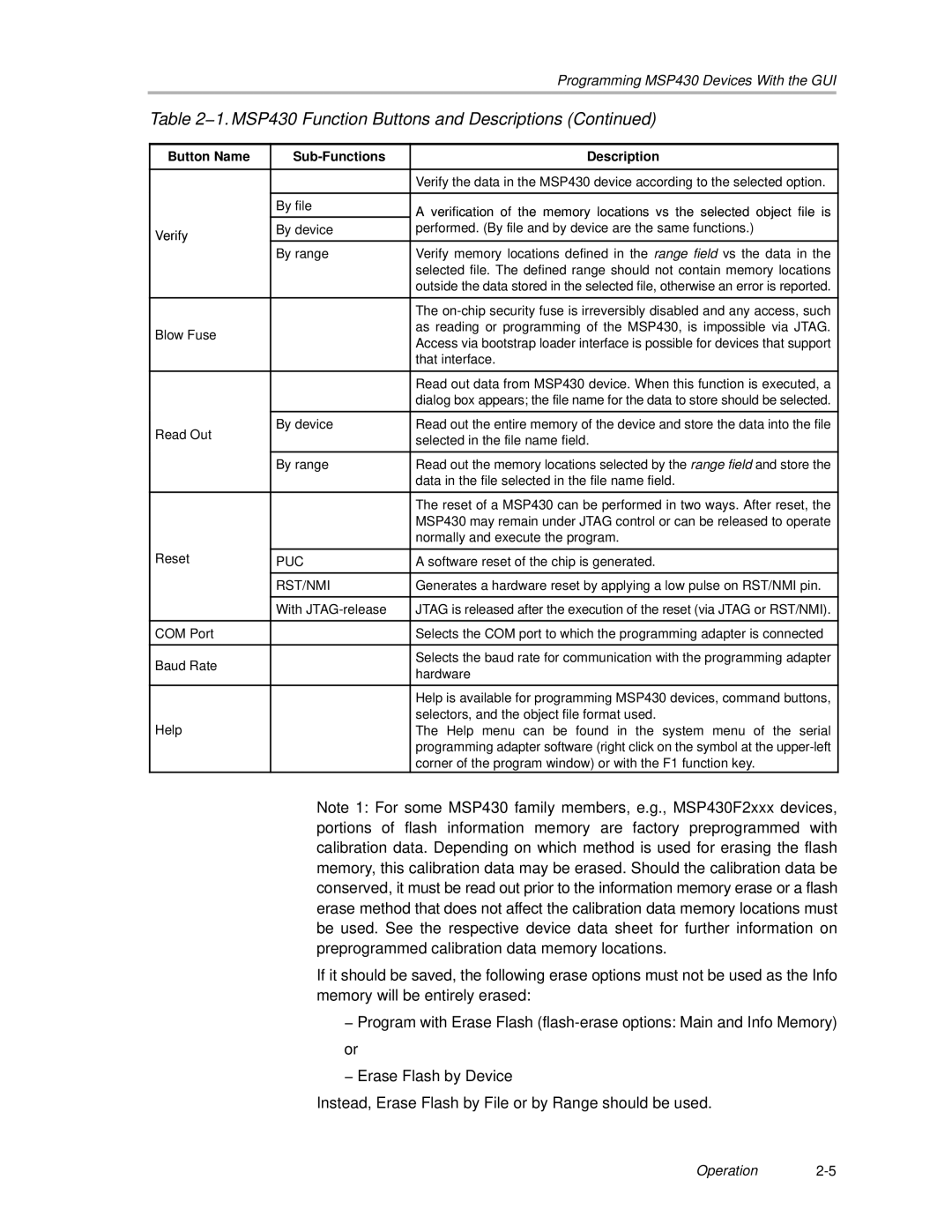|
| Programming MSP430 Devices With the GUI |
Table 2−1. MSP430 Function Buttons and Descriptions (Continued) | ||
|
|
|
Button Name |
| Description |
|
|
|
|
| Verify the data in the MSP430 device according to the selected option. |
|
|
|
| By file | A verification of the memory locations vs the selected object file is |
|
| |
Verify | By device | performed. (By file and by device are the same functions.) |
|
| |
| By range | Verify memory locations defined in the range field vs the data in the |
|
| selected file. The defined range should not contain memory locations |
|
| outside the data stored in the selected file, otherwise an error is reported. |
|
|
|
|
| The |
Blow Fuse |
| as reading or programming of the MSP430, is impossible via JTAG. |
| Access via bootstrap loader interface is possible for devices that support | |
|
| |
|
| that interface. |
|
|
|
|
| Read out data from MSP430 device. When this function is executed, a |
|
| dialog box appears; the file name for the data to store should be selected. |
|
|
|
Read Out | By device | Read out the entire memory of the device and store the data into the file |
| selected in the file name field. | |
|
| |
|
|
|
| By range | Read out the memory locations selected by the range field and store the |
|
| data in the file selected in the file name field. |
|
|
|
|
| The reset of a MSP430 can be performed in two ways. After reset, the |
|
| MSP430 may remain under JTAG control or can be released to operate |
|
| normally and execute the program. |
Reset |
|
|
PUC | A software reset of the chip is generated. | |
|
|
|
| RST/NMI | Generates a hardware reset by applying a low pulse on RST/NMI pin. |
|
|
|
| With | JTAG is released after the execution of the reset (via JTAG or RST/NMI). |
|
|
|
COM Port |
| Selects the COM port to which the programming adapter is connected |
|
|
|
Baud Rate |
| Selects the baud rate for communication with the programming adapter |
| hardware | |
|
| |
|
|
|
|
| Help is available for programming MSP430 devices, command buttons, |
|
| selectors, and the object file format used. |
Help |
| The Help menu can be found in the system menu of the serial |
|
| programming adapter software (right click on the symbol at the |
|
| corner of the program window) or with the F1 function key. |
Note 1: For some MSP430 family members, e.g., MSP430F2xxx devices, portions of flash information memory are factory preprogrammed with calibration data. Depending on which method is used for erasing the flash memory, this calibration data may be erased. Should the calibration data be conserved, it must be read out prior to the information memory erase or a flash erase method that does not affect the calibration data memory locations must be used. See the respective device data sheet for further information on preprogrammed calibration data memory locations.
If it should be saved, the following erase options must not be used as the Info memory will be entirely erased:
−Program with Erase Flash
−Erase Flash by Device
Instead, Erase Flash by File or by Range should be used.
